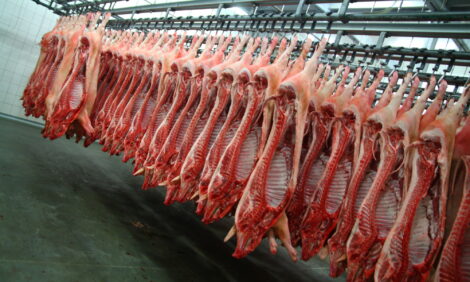



Pork Outlook Report - April 2003
By U.S.D.A., Economic Research Service - This article is an extract from the April 2003: Livestock, Dairy and Poultry Outlook Report, highlighting Global Pork Industry data. The report indicates that retail pork prices are expected to be higher in the second half of 2003, reflecting lower pork and competing meat production.| Overview |

Total meat production in 2003 is expected to drop 1-2 percent from last year, with all
species registering declines.
The March Quarterly Hogs and Pigs report indicated that producers continued to reduce
their breeding herds and year-over-year farrowing intentions. These reductions point to a
smaller pig crop and lower hog slaughter in 2003. If dressed weights continue to
increase, the decline in pork production in 2003 may be held to less than 1 percent. Hog
prices are likely to average $38-$40 per hundredweight (cwt) in 2003, compared with
$35 last year, reflecting lower production of pork and competing meats.
| Lower Inventories, Intentions for Swine |
 Continued breeding herd reduction and lower year over-
year producer farrowing intentions (reported
in the Quarterly Hogs and Pigs report released on
March 28) point to a smaller pig crop and lower
hog slaughter in 2003. If dressed weights continue
to average a pound above last year, however, pork
production declines are likely to be held to less
than 1 percent below a year ago. Hog prices are
likely to average $38-$40 per hundredweight (cwt)
in 2003, compared with $35 last year, due to lower
animal supplies. Retail pork prices are expected to
be higher in the second half of 2003, reflecting
lower pork and competing meat production.
Continued breeding herd reduction and lower year over-
year producer farrowing intentions (reported
in the Quarterly Hogs and Pigs report released on
March 28) point to a smaller pig crop and lower
hog slaughter in 2003. If dressed weights continue
to average a pound above last year, however, pork
production declines are likely to be held to less
than 1 percent below a year ago. Hog prices are
likely to average $38-$40 per hundredweight (cwt)
in 2003, compared with $35 last year, due to lower
animal supplies. Retail pork prices are expected to
be higher in the second half of 2003, reflecting
lower pork and competing meat production.
Commercial hog slaughter in the first quarter of
2003 totaled just over 24.6 million head. Higher
slaughter plus heavier dressed weights combined to
push commercial pork production more than 2.5
percent ahead of the same period last year. Live
equivalent prices of 51-52 percent lean hogs
averaged $35 in the first quarter, 10 percent below
the first quarter of 2002. Hog prices rose in March
from earlier this year, reflecting seasonal patterns,
but wholesale cut prices remain relatively weak as
pork supplies remain large.
 U.S. packers are expected to slaughter 2 percent
fewer hogs in the April-June quarter, as the
breeding herd reductions that occurred last summer
begin to translate into lower availability of
slaughter hogs. With the average dressed weight
unchanged from a year ago, pork production in the
second quarter of 2003 should drop by about 2
percent. Hog prices are expected to average $39-
$41 in the April-June quarter. Retail pork prices
are expected to average more than 5 cents above
the first quarter, reflecting lower pork supplies.
U.S. packers are expected to slaughter 2 percent
fewer hogs in the April-June quarter, as the
breeding herd reductions that occurred last summer
begin to translate into lower availability of
slaughter hogs. With the average dressed weight
unchanged from a year ago, pork production in the
second quarter of 2003 should drop by about 2
percent. Hog prices are expected to average $39-
$41 in the April-June quarter. Retail pork prices
are expected to average more than 5 cents above
the first quarter, reflecting lower pork supplies.
The Quarterly Hogs and Pigs report indicated that
the March 1 inventory of U.S. breeding swine fell 4
percent below herd levels of 2002. The December-
February pig crop was 2 percent lower than in the
same period last year. The lower pig crop implies
a 3-percent lower slaughter in the July-September
quarter, but declines in production should be held
to less than 3 percent below a year ago, if weather
and feed costs continue to support weights above
last year’s levels.
Producers indicated intentions to farrow fewer
sows in March-August 2003. If producer
intentions are realized, 3 percent fewer breeding
animals will farrow during the March-May quarter
than in the same period last year, suggesting a
lower slaughter in the fourth quarter of this year.
Hog slaughter in the October-December quarter is
expected to fall about 2 percent below the fourth
quarter slaughter of last year. Fourth quarter
weights are expected to average a pound above last
year, implying pork production 1 percent below
last year. Hog prices are expected to be $36-$40
per cwt in the fourth quarter. Producers’ intentions
to farrow 3 percent fewer sows in June-August
2003, than in the same quarter of 2002, indicates
less pork production in the first quarter of 2004.
| Further information |
Links
For more information view the full Livestock, Dairy and Poultry Outlook - April 2003 (pdf)Source: Livestock, Dairy and Poultry Outlook - U.S. Department of Agriculture, Economic Research Service - April, 2003








